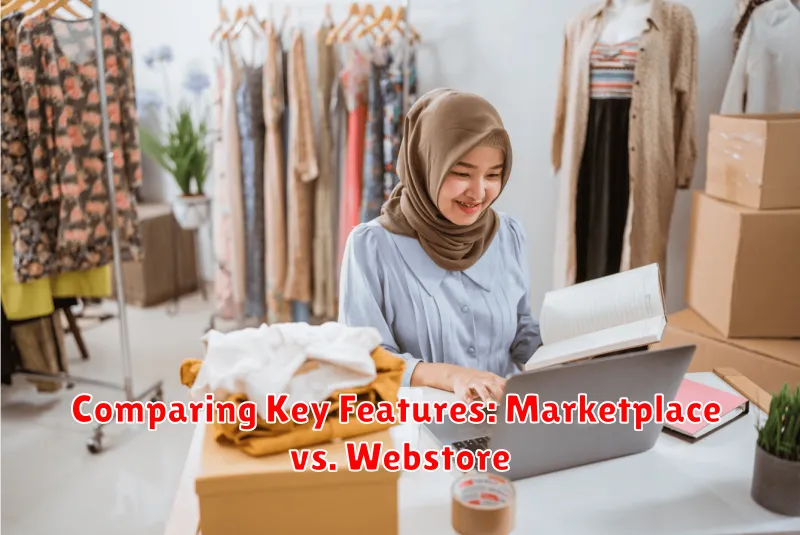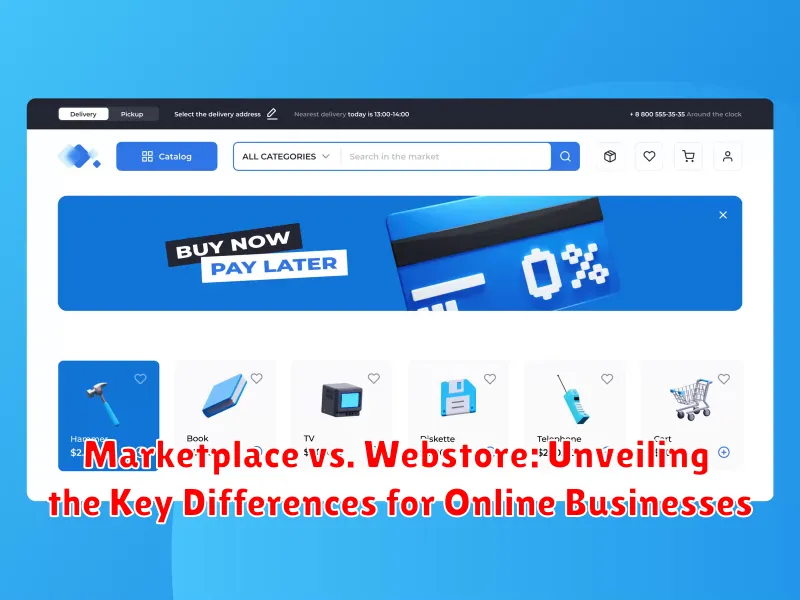In the dynamic landscape of online commerce, businesses face a crucial decision: establishing their presence on an established marketplace or crafting their own dedicated webstore. This choice significantly impacts brand identity, control over customer experience, and ultimately, profitability. Understanding the core distinctions between a marketplace and a webstore is paramount for making informed decisions tailored to specific business objectives. This article delves into the key differences between these two prominent online business models, providing insights to guide your strategic choices. Whether you are a budding entrepreneur or an established business seeking to expand your digital footprint, a thorough understanding of the marketplace vs. webstore debate is essential for success in the competitive online business environment.
Navigating the complexities of online businesses requires a nuanced comprehension of the available platforms. Marketplaces, such as Amazon and Etsy, offer immediate access to a large customer base and streamlined logistics, presenting an attractive option for businesses looking for quick entry into the online marketplace. Conversely, a webstore provides unparalleled control over branding, customer experience, and data, enabling businesses to cultivate a unique identity and foster direct relationships with their customers. Weighing the differences between the marketplace model and the webstore model requires careful consideration of factors such as scalability, cost, and long-term brand building. This exploration of the marketplace vs. webstore dichotomy aims to equip you with the knowledge to make the best decision for your online business aspirations.
Understanding the Core Concepts of Marketplaces
Marketplaces are essentially online platforms that connect buyers and sellers, acting as intermediaries facilitating transactions. They provide a centralized space where multiple vendors can list and sell their products or services to a large, pre-existing customer base.
Think of a marketplace as a digital shopping mall. Individual businesses operate their own “stores” (virtual storefronts) within the larger marketplace environment. The marketplace operator manages the platform’s infrastructure, marketing, and payment processing, while sellers focus on product sourcing, inventory management, and customer service for their specific offerings.
Key characteristics of marketplaces include:
- Multiple vendors: A diverse range of sellers offering various products and services.
- Centralized platform: A single website or app where buyers can browse and purchase from multiple sellers.
- Standardized processes: Established rules and guidelines for sellers regarding listing, payments, and customer service.
- Built-in audience: Access to a large pool of potential customers already using the marketplace.
Exploring the Advantages of Selling on Marketplaces
Marketplaces offer several compelling advantages for online businesses, particularly those starting out or seeking broader reach. A primary benefit is built-in traffic. Marketplaces already attract a large customer base actively searching for products, giving sellers immediate exposure to potential buyers without extensive marketing efforts.
Simplified setup is another advantage. Creating a seller account and listing products is generally straightforward, requiring minimal technical expertise. This allows businesses to quickly establish an online presence and begin selling. Furthermore, marketplaces often handle complex aspects like payment processing and customer service, freeing up sellers to focus on core business operations.
Increased brand visibility is a key benefit of leveraging established marketplaces. The platform’s reputation and marketing efforts can significantly enhance a seller’s reach and introduce their products to a wider audience than they might achieve independently.
Delving into the Benefits of Owning a Webstore
Owning a webstore offers distinct advantages, primarily centered around control and branding. With a webstore, you have complete authority over the customer experience, from website design and functionality to branding elements and marketing strategies.
Enhanced Brand Identity: A webstore allows you to cultivate a unique brand identity, unconstrained by the standardized environment of a marketplace. You can tailor the look and feel of your online store to perfectly reflect your brand values and resonate with your target audience.
Direct Customer Relationships: Building direct relationships with customers is crucial for long-term growth. A webstore empowers you to collect customer data, personalize interactions, and foster loyalty through targeted marketing campaigns and exclusive offers. This direct access to customer information is invaluable for understanding their needs and preferences.
Greater Control Over Pricing and Promotions: Unlike marketplaces that may impose pricing restrictions or participate in platform-wide sales, a webstore gives you complete autonomy over pricing strategies and promotional activities. You can implement dynamic pricing models, create customized discounts, and bundle products to maximize revenue.
Analyzing the Drawbacks of Marketplaces and Webstores
While both marketplaces and webstores offer distinct advantages, they also come with their own set of drawbacks. Understanding these limitations is crucial for making informed decisions about your online business strategy.
Marketplace Drawbacks
Marketplaces, despite their wide reach, often impose restrictions on branding and customization. This can make it difficult to establish a unique brand identity. Competition is fierce within marketplaces, and sellers may find themselves struggling to stand out. Fees and commissions can also significantly impact profit margins.
Webstore Drawbacks
Operating a webstore demands significant upfront investment in development and maintenance. Driving traffic and attracting customers requires dedicated marketing efforts, which can be time-consuming and costly. Handling customer service, order fulfillment, and security also become the sole responsibility of the business owner.
Comparing Key Features: Marketplace vs. Webstore

This table summarizes the key differences between selling on a marketplace and operating your own webstore:
| Feature | Marketplace | Webstore |
|---|---|---|
| Reach | Large, built-in audience | Requires marketing and SEO |
| Control | Limited, subject to platform rules | Full control over branding and customer experience |
| Cost | Fees/commissions per sale | Setup and maintenance costs |
| Branding | Limited branding opportunities | Full branding control |
| Customer Data | Limited access to customer data | Own and manage all customer data |
| Competition | High competition from other sellers | Potentially less direct competition |
Making the Right Choice for Your Business Needs
Choosing between a marketplace and a webstore depends entirely on your specific business goals and resources. Consider the following factors to make an informed decision:
Control and Branding
Webstores offer greater control over branding and customer experience. You dictate the look, feel, and functionality of your online store. Marketplaces, however, prioritize their own branding, limiting your ability to create a unique brand identity.
Cost and Time Investment
Setting up a webstore requires a larger upfront investment in website development, hosting, and marketing. Marketplaces offer a lower barrier to entry with existing infrastructure and customer base, although they charge commissions and fees.
Target Audience and Reach
Marketplaces provide immediate access to a large pre-existing audience, offering wider reach. Webstores require dedicated marketing efforts to attract customers, but offer greater control over customer relationships.
Technical Expertise
Managing a webstore demands more technical expertise for website maintenance, security, and updates. Marketplaces handle the technical aspects, allowing you to focus on sales and product management.
Real-World Examples of Successful Marketplaces and Webstores

Marketplaces
Etsy stands as a prime example of a thriving marketplace, connecting millions of independent sellers with buyers seeking unique, handcrafted, and vintage items. Its strength lies in the diverse product offerings and the vast customer base it provides sellers.
Amazon Marketplace exemplifies a massive online marketplace where third-party sellers operate alongside Amazon’s own retail operations. This platform offers sellers access to an established fulfillment network and a huge customer base, enabling significant reach and scalability.
Webstores
Nike‘s official website serves as a highly successful example of a webstore. It allows the company to maintain complete control over branding, customer experience, and product presentation, fostering a direct relationship with consumers.
Apple‘s online store embodies a successful webstore model, offering a seamless shopping experience that integrates hardware, software, and services while showcasing the brand’s premium aesthetic and innovative products.

